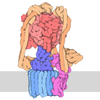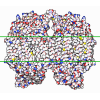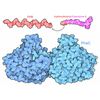[English] 日本語
 Yorodumi
Yorodumi- PDB-6yny: Cryo-EM structure of Tetrahymena thermophila mitochondrial ATP sy... -
+ Open data
Open data
- Basic information
Basic information
| Entry | Database: PDB / ID: 6yny | ||||||||||||
|---|---|---|---|---|---|---|---|---|---|---|---|---|---|
| Title | Cryo-EM structure of Tetrahymena thermophila mitochondrial ATP synthase - F1Fo composite dimer model | ||||||||||||
 Components Components |
| ||||||||||||
 Keywords Keywords | MEMBRANE PROTEIN / mitochondria / ATP synthase / F1Fo dimer / IF1 dimer | ||||||||||||
| Function / homology |  Function and homology information Function and homology information: / sulfide oxidation, using sulfide:quinone oxidoreductase / sulfide:quinone oxidoreductase activity / cellular lipid metabolic process / carboxylic ester hydrolase activity / : / : / : / : / proton-transporting ATP synthase complex, coupling factor F(o) ...: / sulfide oxidation, using sulfide:quinone oxidoreductase / sulfide:quinone oxidoreductase activity / cellular lipid metabolic process / carboxylic ester hydrolase activity / : / : / : / : / proton-transporting ATP synthase complex, coupling factor F(o) / : / proton motive force-driven ATP synthesis / proton transmembrane transporter activity / photosynthetic electron transport in photosystem I / proton motive force-driven mitochondrial ATP synthesis / chloroplast thylakoid membrane / proton-transporting ATP synthase complex, catalytic core F(1) / photosynthetic electron transport in photosystem II / H+-transporting two-sector ATPase / proton-transporting ATPase activity, rotational mechanism / FAD binding / proton-transporting ATP synthase activity, rotational mechanism / ADP binding / hydrolase activity / lipid binding / ATP hydrolysis activity / mitochondrion / ATP binding / membrane / plasma membrane Similarity search - Function | ||||||||||||
| Biological species |  | ||||||||||||
| Method | ELECTRON MICROSCOPY / single particle reconstruction / cryo EM / Resolution: 2.7 Å | ||||||||||||
 Authors Authors | Kock Flygaard, R. / Muhleip, A. / Amunts, A. | ||||||||||||
| Funding support |  Sweden, 3items Sweden, 3items
| ||||||||||||
 Citation Citation |  Journal: Nat Commun / Year: 2020 Journal: Nat Commun / Year: 2020Title: Type III ATP synthase is a symmetry-deviated dimer that induces membrane curvature through tetramerization. Authors: Rasmus Kock Flygaard / Alexander Mühleip / Victor Tobiasson / Alexey Amunts /  Abstract: Mitochondrial ATP synthases form functional homodimers to induce cristae curvature that is a universal property of mitochondria. To expand on the understanding of this fundamental phenomenon, we ...Mitochondrial ATP synthases form functional homodimers to induce cristae curvature that is a universal property of mitochondria. To expand on the understanding of this fundamental phenomenon, we characterized the unique type III mitochondrial ATP synthase in its dimeric and tetrameric form. The cryo-EM structure of a ciliate ATP synthase dimer reveals an unusual U-shaped assembly of 81 proteins, including a substoichiometrically bound ATPTT2, 40 lipids, and co-factors NAD and CoQ. A single copy of subunit ATPTT2 functions as a membrane anchor for the dimeric inhibitor IF. Type III specific linker proteins stably tie the ATP synthase monomers in parallel to each other. The intricate dimer architecture is scaffolded by an extended subunit-a that provides a template for both intra- and inter-dimer interactions. The latter results in the formation of tetramer assemblies, the membrane part of which we determined to 3.1 Å resolution. The structure of the type III ATP synthase tetramer and its associated lipids suggests that it is the intact unit propagating the membrane curvature. | ||||||||||||
| History |
|
- Structure visualization
Structure visualization
| Movie |
 Movie viewer Movie viewer |
|---|---|
| Structure viewer | Molecule:  Molmil Molmil Jmol/JSmol Jmol/JSmol |
- Downloads & links
Downloads & links
- Download
Download
| PDBx/mmCIF format |  6yny.cif.gz 6yny.cif.gz | 5.7 MB | Display |  PDBx/mmCIF format PDBx/mmCIF format |
|---|---|---|---|---|
| PDB format |  pdb6yny.ent.gz pdb6yny.ent.gz | Display |  PDB format PDB format | |
| PDBx/mmJSON format |  6yny.json.gz 6yny.json.gz | Tree view |  PDBx/mmJSON format PDBx/mmJSON format | |
| Others |  Other downloads Other downloads |
-Validation report
| Summary document |  6yny_validation.pdf.gz 6yny_validation.pdf.gz | 3.9 MB | Display |  wwPDB validaton report wwPDB validaton report |
|---|---|---|---|---|
| Full document |  6yny_full_validation.pdf.gz 6yny_full_validation.pdf.gz | 4.1 MB | Display | |
| Data in XML |  6yny_validation.xml.gz 6yny_validation.xml.gz | 388.1 KB | Display | |
| Data in CIF |  6yny_validation.cif.gz 6yny_validation.cif.gz | 614.6 KB | Display | |
| Arichive directory |  https://data.pdbj.org/pub/pdb/validation_reports/yn/6yny https://data.pdbj.org/pub/pdb/validation_reports/yn/6yny ftp://data.pdbj.org/pub/pdb/validation_reports/yn/6yny ftp://data.pdbj.org/pub/pdb/validation_reports/yn/6yny | HTTPS FTP |
-Related structure data
| Related structure data |  10860MC  6ynvC  6ynwC  6ynxC  6ynzC  6yo0C M: map data used to model this data C: citing same article ( |
|---|---|
| Similar structure data |
- Links
Links
- Assembly
Assembly
| Deposited unit | 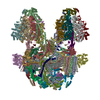
|
|---|---|
| 1 |
|
- Components
Components
+Protein , 28 types, 81 molecules aAbBdDfFiIkKcCgGhHjJlLmMnNoOpP...
-Non-polymers , 9 types, 70 molecules 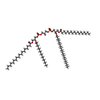
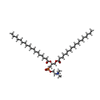




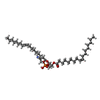
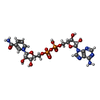









| #29: Chemical | ChemComp-CDL / #30: Chemical | ChemComp-PC1 / #31: Chemical | #32: Chemical | #33: Chemical | ChemComp-ATP / #34: Chemical | ChemComp-MG / #35: Chemical | ChemComp-PEE / #36: Chemical | #37: Chemical | ChemComp-ADP / |
|---|
-Details
| Has ligand of interest | N |
|---|
-Experimental details
-Experiment
| Experiment | Method: ELECTRON MICROSCOPY |
|---|---|
| EM experiment | Aggregation state: PARTICLE / 3D reconstruction method: single particle reconstruction |
- Sample preparation
Sample preparation
| Component | Name: Mitochondrial ATP synthase, F1Fo dimer / Type: COMPLEX / Entity ID: #1-#28 / Source: NATURAL |
|---|---|
| Molecular weight | Experimental value: NO |
| Source (natural) | Organism:  |
| Buffer solution | pH: 7.5 |
| Specimen | Conc.: 0.75 mg/ml / Embedding applied: NO / Shadowing applied: NO / Staining applied: NO / Vitrification applied: YES |
| Specimen support | Grid material: COPPER / Grid mesh size: 300 divisions/in. / Grid type: Quantifoil R2/2 |
| Vitrification | Instrument: FEI VITROBOT MARK IV / Cryogen name: ETHANE |
- Electron microscopy imaging
Electron microscopy imaging
| Experimental equipment |  Model: Titan Krios / Image courtesy: FEI Company |
|---|---|
| Microscopy | Model: FEI TITAN KRIOS |
| Electron gun | Electron source:  FIELD EMISSION GUN / Accelerating voltage: 300 kV / Illumination mode: FLOOD BEAM FIELD EMISSION GUN / Accelerating voltage: 300 kV / Illumination mode: FLOOD BEAM |
| Electron lens | Mode: BRIGHT FIELD / Nominal magnification: 165000 X |
| Image recording | Electron dose: 30.9 e/Å2 / Detector mode: COUNTING / Film or detector model: GATAN K2 QUANTUM (4k x 4k) |
| EM imaging optics | Energyfilter name: GIF Quantum LS / Energyfilter slit width: 20 eV |
| Image scans | Movie frames/image: 20 |
- Processing
Processing
| EM software |
| |||||||||||||||||||||||||||||||||||
|---|---|---|---|---|---|---|---|---|---|---|---|---|---|---|---|---|---|---|---|---|---|---|---|---|---|---|---|---|---|---|---|---|---|---|---|---|
| CTF correction | Type: PHASE FLIPPING AND AMPLITUDE CORRECTION | |||||||||||||||||||||||||||||||||||
| Symmetry | Point symmetry: C1 (asymmetric) | |||||||||||||||||||||||||||||||||||
| 3D reconstruction | Resolution: 2.7 Å / Resolution method: FSC 0.143 CUT-OFF / Num. of particles: 61157 / Symmetry type: POINT |
 Movie
Movie Controller
Controller











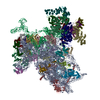

 PDBj
PDBj
